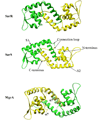The SarA protein family of Staphylococcus aureus
- PMID: 18083623
- PMCID: PMC2274939
- DOI: 10.1016/j.biocel.2007.10.032
The SarA protein family of Staphylococcus aureus
Abstract
Staphylococcus aureus is widely appreciated as an opportunistic pathogen, primarily in hospital-related infections. However, recent reports indicate that S. aureus infections can now occur in other wise healthy individuals in the community setting. The success of this organism can be attributed to the large array of regulatory proteins, including the SarA protein family, used to respond to changing microenvironments. Sequence alignment and structural data reveal that the SarA protein family can be divided into three subfamilies: (1) single domain proteins; (2) double domain proteins; (3) MarR homologs. Structural studies have also demonstrated that SarA, SarR, SarS, MgrA and thus possibly all members of this protein family are winged helix proteins with minor variations. Mutagenesis studies of SarA disclose that the winged helix motifs are important for DNA binding and function. Recent progress concerning the functions and plausible mechanisms of regulation of SarA and its homologs are discussed.
Figures



Similar articles
-
Crystal structure of the SarS protein from Staphylococcus aureus.J Bacteriol. 2003 Jul;185(14):4219-25. doi: 10.1128/JB.185.14.4219-4225.2003. J Bacteriol. 2003. PMID: 12837797 Free PMC article.
-
Global regulation of virulence determinants in Staphylococcus aureus by the SarA protein family.Front Biosci. 2002 Aug 1;7:d1825-42. doi: 10.2741/A882. Front Biosci. 2002. PMID: 12133812 Review.
-
Transcriptional regulation of the agr locus and the identification of DNA binding residues of the global regulatory protein SarR in Staphylococcus aureus.Mol Microbiol. 2006 Jun;60(5):1289-301. doi: 10.1111/j.1365-2958.2006.05171.x. Mol Microbiol. 2006. PMID: 16689803
-
Are the structures of SarA and SarR similar?Trends Microbiol. 2001 Dec;9(12):570-3. doi: 10.1016/s0966-842x(01)02253-3. Trends Microbiol. 2001. PMID: 11728861 No abstract available.
-
Regulation of virulence determinants in vitro and in vivo in Staphylococcus aureus.FEMS Immunol Med Microbiol. 2004 Jan 15;40(1):1-9. doi: 10.1016/S0928-8244(03)00309-2. FEMS Immunol Med Microbiol. 2004. PMID: 14734180 Review.
Cited by
-
Nusbiarylins Inhibit Transcription and Target Virulence Factors in Bacterial Pathogen Staphylococcus aureus.Int J Mol Sci. 2020 Aug 11;21(16):5772. doi: 10.3390/ijms21165772. Int J Mol Sci. 2020. PMID: 32796751 Free PMC article.
-
Cutaneous Immune Defenses Against Staphylococcus aureus Infections.J Lifestyle Med. 2014 Mar;4(1):39-46. doi: 10.15280/jlm.2014.4.1.39. Epub 2014 Mar 31. J Lifestyle Med. 2014. PMID: 26064853 Free PMC article. Review.
-
The SaeRS Two-Component System of Staphylococcus aureus.Genes (Basel). 2016 Oct 3;7(10):81. doi: 10.3390/genes7100081. Genes (Basel). 2016. PMID: 27706107 Free PMC article. Review.
-
Transcriptional profiling of XdrA, a new regulator of spa transcription in Staphylococcus aureus.J Bacteriol. 2010 Oct;192(19):5151-64. doi: 10.1128/JB.00491-10. Epub 2010 Jul 30. J Bacteriol. 2010. PMID: 20675497 Free PMC article.
-
Regulation of neutrophil myeloperoxidase inhibitor SPIN by the small RNA Teg49 in Staphylococcus aureus.Mol Microbiol. 2022 Jun;117(6):1447-1463. doi: 10.1111/mmi.14919. Epub 2022 May 31. Mol Microbiol. 2022. PMID: 35578788 Free PMC article.
References
-
- Arvidson S, Tegmark K. Regulation of virulence determinants in Staphylococcus aureus. Int. J. Med. Microbiol. 2001;291:159–170. - PubMed
-
- Chen PR, Bae T, Williams WA, Duguid EM, Rice PA, Schneewind O, He C. An oxidation-sensing mechanism is used by the global regulator MgrA in Staphylococcus aureus. Nat. Chem. Biol. 2006;2:591–595. - PubMed
-
- Cheung AL, Bayer AS, Zhang G, Gresham H, Xiong Y-Q. Regulation of virulence determinants in vitro and in vivo in Staphylococcus aureus. FEMS Microbiol.Lett. 2004;1649:1–9. - PubMed
-
- Crossley KB, Archer GL. The staphylococci in human disease. New York: Churchill Livingston; 1997.
Publication types
MeSH terms
Substances
Grants and funding
LinkOut - more resources
Full Text Sources
Medical
Molecular Biology Databases
Miscellaneous

